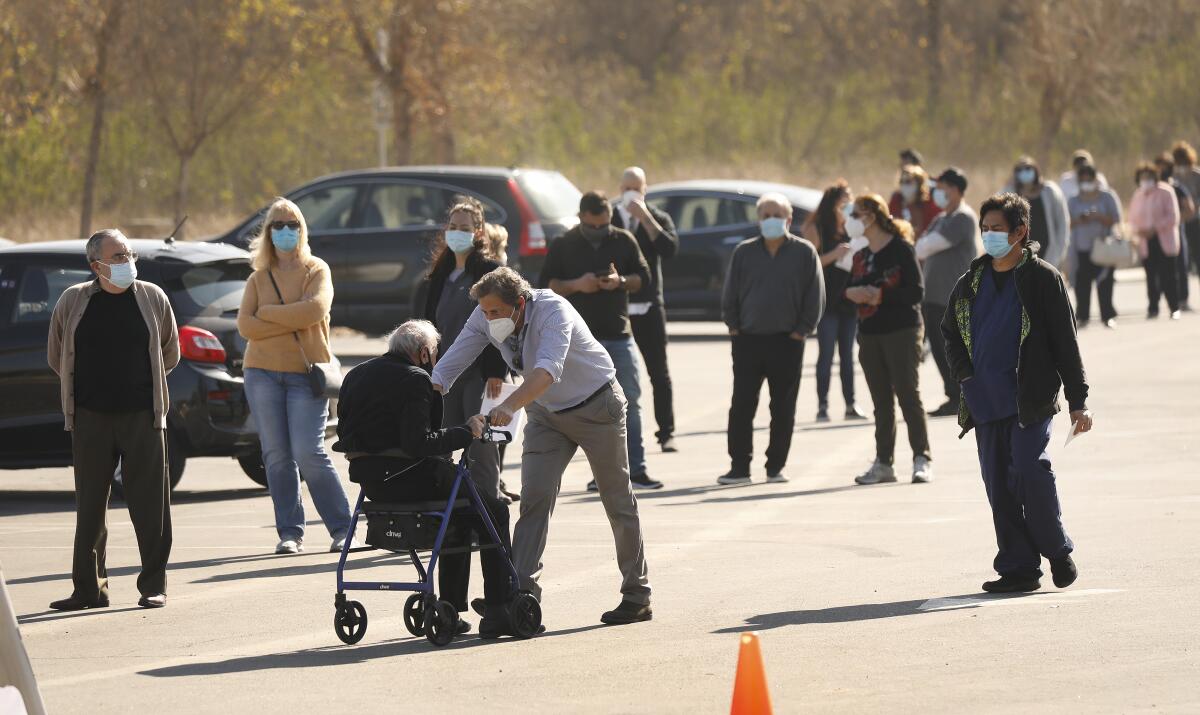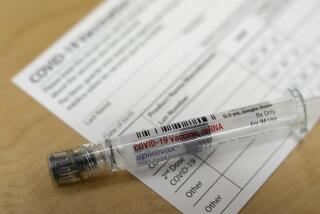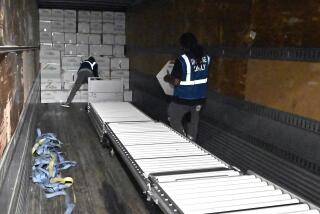U.S. vaccination campaign runs far behind schedule

- Share via
Operation Warp Speed promised to accelerate the development, manufacturing and distribution of COVID-19 vaccines.
“That means big, and it means fast — a massive scientific, industrial and logistical endeavor,” President Trump said at a press conference announcing the effort last May.
The administration came through on the scientific front, shattering the record for bringing a vaccine to market and silencing critics who said it would take years.
But so far the operation is failing in its other core mission: getting vaccines to the American public.
Despite months to prepare, the distribution effort appears to be buckling under the weight of bureaucracy. Sign-up hotlines and websites have crashed. The massive demand is also evident in the long lines of seniors camped out at health clinics.
At the current rate, it would take years to vaccinate the U.S. public.
“There does seem to have been a pretty substantial breakdown in the planning process,” said David Johnson, a Chicago-based healthcare consultant. “The feds were just focused on, ‘OK, we’re just going to get the vaccines to your doorstep.’”
More than 17 million doses of COVID-19 vaccine have been shipped to hospitals and pharmacies across the country, but as of Tuesday morning, fewer than 5 million had been used, according to the U.S. Centers for Disease Control and Prevention.
Federal health officials said in December that they planned to vaccinate 20 million Americans before the new year.
Dr. Anthony Fauci, the nation’s top infectious disease expert, described the problems as “a couple of glitches.”
“So we are not where we want to be, there’s no doubt about that,” he said Sunday. “But I think we can get there if we really accelerate.”
The shots are free of charge, but the federal government has left it up to state officials to decide how to distribute them.
When vaccines arrive at a distribution site, several factors must align. There must be enough freezer space, syringes and health workers to administer the vaccines. Most important, people must be screened for eligibility and instructed when and where to show up for their injections — that’s where most of the breakdowns have occurred.
In Houston, where senior citizens and those ages 16 and up with chronic conditions are eligible, an appointment hotline crashed after 250,000 people called.
People were directed to register in person Saturday at the city’s vaccination clinic, then were told to call for appointments Sunday.
“Vehicles lined up at the site early Sunday morning, many without appointments,” said Scott Packard, a spokesman for the city’s health department. “We decided to serve the people who were in that line with the remaining appointments instead of turning them away.”
The city set up online registration Monday and soon after announced that no more appointments would be available until more vaccine arrived.
Meanwhile, surrounding Harris County received 6,000 doses and attempted to distribute them through county agencies to teachers and to those eligible at nursing homes, homeless shelters and the county jail. But a registration link for those workers crashed after it was leaked last week on social media.
On Monday, Houston Mayor Sylvester Turner promised to set up a “major mega site” for vaccinations by this Saturday.
In Florida’s Lee County, shots were offered first-come, first-serve. News reports showed seniors lining up at the county health department with lawn chairs, waiting hours to see if they’d make the cut.
In Tampa, the Hillsborough County vaccine registration website crashed within minutes of going online Monday morning. The county is now taking reservations by phone only.
Several other Florida counties are using Eventbrite, a website better known for selling concert tickets, to run vaccine registration. Law enforcement this week warned about fake Eventbrite sites that are charging seniors for vaccination appointments that don’t exist.
Registering residents of nursing homes for vaccination faces a different challenge: Under federal law, the residents or their representatives must give informed consent for any treatment.
“We’re seeing a lot of last-minute scrambling,” said Richard Mollot, executive director of the Long Term Care Community Coalition, a New York-based advocacy organization. “This really should have been done months ago, when we knew in advance that hopefully a vaccine was coming.”
He blamed federal officials for failing to let long-term care managers know about the consent requirements.
Under the federal Pharmacy Partnership for Long-Term Care Program, 429,000 residents of long-term care facilities received initial doses out of 3.3 million distributed, the CDC reported Monday.
Meanwhile, in some cases, state and hospital officials are sparring over accusations that unused doses are sitting in health systems.
Texas Gov. Greg Abbott tweeted that “a significant portion of vaccines distributed across Texas might be sitting on hospital shelves as opposed to being given to vulnerable Texans.”
Carrie Williams, a spokeswoman for the Texas Hospital Assn., disputed the claim, saying that “hospitals are moving as fast as humanly possible.”
In New York, Gov. Andrew Cuomo said hospitals that don’t use their supplies within a week of receiving them would be removed from distribution networks and possibly fined $100,000.
“We want those vaccines in peoples’ arms,” he said.
Florida Gov. Ron DeSantis also threatened to take away scheduled shipments from hospitals if they do not vaccinate faster. Hospitals have said they need more staff to administer the vaccines.
Indeed, many of the health systems responsible for distributing the vaccines are struggling to keep up with unprecedented demand for both coronavirus testing and patient care amid a massive surge in infections, according to U.S. Surgeon General Jerome Adams.
Another potential reason for the bottleneck is that high-priority groups like hospital staff have been unexpectedly wary of the injections. A recent survey by the Kaiser Family Foundation found that 29% of healthcare workers were “vaccine hesitant,” slightly more than the general population, at 27%.
In California, for example, almost 500 doses were made available to healthcare workers at St. Elizabeth Community Hospital in Red Bluff in Tehama County. The hospital has since returned about 200 of them to the health department.
About 60% of workers at Ohio’s nursing homes chose to skip the vaccine. And in Washington, after several first responders missed their appointments, a pharmacist flagged down a law student buying groceries and offered him a dose to keep it from going to waste — an emergency measure allowed under local health guidelines.
The sluggish rollout bodes poorly for hopes of quickly vaccinating large numbers of people and achieving herd immunity, which experts say is essential to containing the virus.
Johnson, the healthcare consultant, said the situation reminds him of the rollout of Obamacare, when the Affordable Care Act’s bungled website threatened to derail the system. The HealthCare.gov website crashed just two hours after launching in 2013 and later could handle only about 35,000 visitors at a time.
“How hard is it to design a website, and yet that is the thing they stubbed their toe on,” Johnson said.
The debacle undermined confidence in the system and gave critics an opening — and the same could happen with the COVID-19 vaccine, he said.
“If we’re not effective on the rollout, the encouragement to take the vaccine doesn’t carry as much weight,” he said.
Baumgaertner and Kaleem reported from Los Angeles, Hennessy-Fiske from Houston and Read from Seattle.
More to Read
Sign up for Essential California
The most important California stories and recommendations in your inbox every morning.
You may occasionally receive promotional content from the Los Angeles Times.














